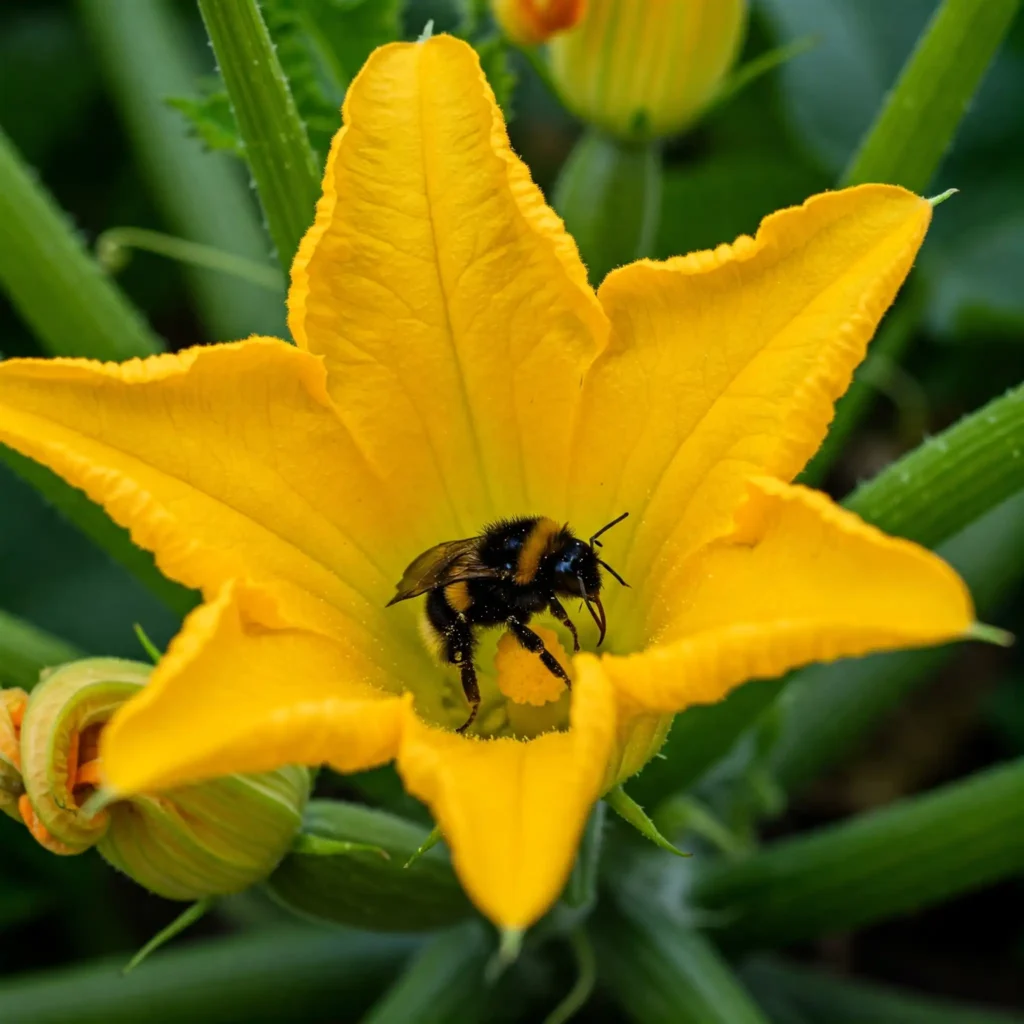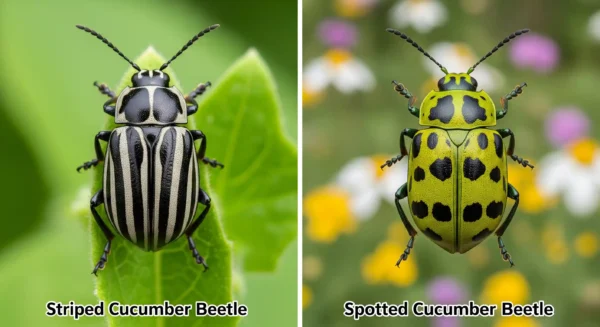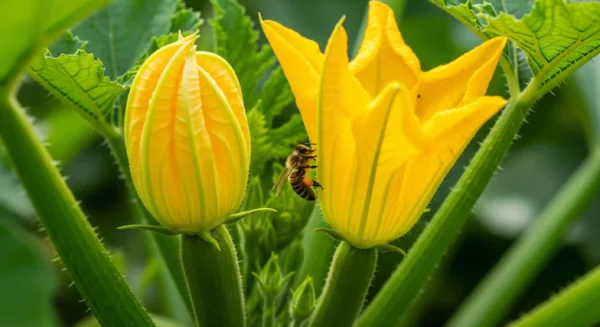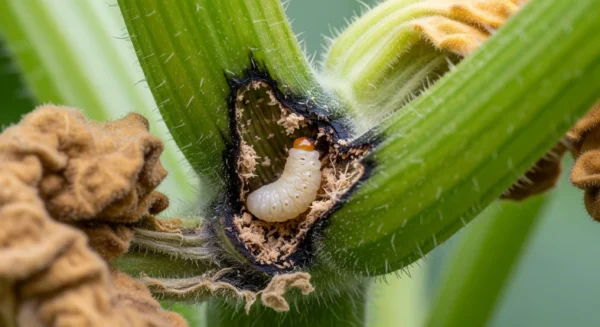Why Your Zucchini Fruits Are Lumpy, Misshapen or Deformed? What’s happening?
You’ve nurtured your zucchini plants, seen those large yellow flowers burst open early and bright, and couldn’t wait for the first delicious fruits! You’ve imagined grilled slices, perhaps some zoodles… At last, you reach down through those large leaves to select one; what you take seems more like a lumpy old cucumber than a nice smooth, green torpedo. Perhaps it’s like a bowling pin with a thin waist and a fat, bulbous end. What gives? What causes your zucchinis to be all bumpy, tight, misshapen, or simply odd looking? It can be rather perplexing!
Don’t worry; although it may seem odd, it’s really rather typical in the garden and often not a sign of a significant catastrophe brewing or some awful plant disease. More often than not, those strangely shaped zucchinis are just telling you a story about something that occurred—or didn’t occur—during their very early development, right after the flower stage. Rather than viewing it as a gardening failure, consider it as a fascinating natural anomaly revealing to you how sensitive fruit growth can be!
But alright, setting aside curiosity, what really creates these odd forms? Is the fruit still safe to eat (spoiler: usually yes!)? And perhaps more significantly, can you do anything to promote more uniformly formed zucchini the next time you plant? This book aims to specifically address those queries! We’ll look at the most frequent causes of lumpy, bumpy, tight, or otherwise distorted zucchini and provide some straightforward, useful advice. Let’s don our detective caps and look into the case of the inquisitive zucchini!
The Prime Suspect: Incomplete or Poor Pollination
Usually, nine times out of ten, this is the main cause of strangely shaped zucchini. It all comes back to how these plants produce babies—or, well, fruits! Recall how zucchini plants have distinct male flowers (on long, thin stems) and female flowers (with the little baby zucchini already apparent behind the petals)? Pollen has to travel from a male flower’s stamen to the female flower’s stigma if that little baby zucchini is to develop into the full-sized fruit we desire. Usually, bees take care of this delivery service.
How It Functions (or Doesn’t!): Imagine the inside of that female flower’s stigma as having several landing zones linked to little possible seeds (ovules) inside that baby zucchini (the ovary). Most of those landing zones have to get a good dusting of pollen, so fertilizing most of the ovules, which will allow the fruit to puff up uniformly all around and develop into that classic, smooth zucchini shape.
The Outcome of Patchy Work: Now, what happens if a bee visits but doesn’t quite do a thorough job? Perhaps there simply weren’t enough bee visits, though. Should some areas of the stigma get pollen, then only some of the ovules become fertilized. Driven by the plant’s energy, the portions of the fruit linked to those fertilised ovules will begin to swell and develop. What about the areas linked to the unpollinated parts? They simply lack the growth signal, thus they either fall behind or cease developing completely.
Common Shapes Emerging from This: This uneven growth causes directly those traditional misshapen shapes we frequently observe:
- Pinched Blossom End: The stem end got pollinated and started growing; the far end (where the flower was) didn’t get enough pollen, so it stays skinny and underdeveloped.
- Bulbous Blossom End: The reverse occurs: the blossom end got lots of pollen and swelled up beautifully, but the stem end did not, so the fruit resembles a club or a bowling pin.
- Curved Fruit: Uneven pollination down the length of the ovary causes one side of the fruit to grow much faster than the other, which may cause the zucchini to grow into a major curve or bend.
- Generally Lumpy/Bumpy/Constricted: Occasionally, the pollination is simply generally patchy, resulting in total uneven, lumpy, or constricted growth along the length of the fruit.
What Causes Pollination to Fail? Many things can disrupt the bees’ vital labor:
- Too Few Bees: This is a major issue. Perhaps the morning hours when the flowers are open have been persistently rainy, cool, or windy, which would have kept bees hunkered down. Your garden might also lack other flowers required to draw and maintain a good pollinator population close by. An area’s extensive pesticide use can also significantly lower bee populations.
- Flower Timing Mismatch: Sometimes the plant simply gets out of sync. It might generate a lot of male flowers before any females show, or the other way around (although the former is more usual). Pollination can only happen if both male and female flowers are open simultaneously; usually, each flower only lasts one morning!
- Interrupted Visit: A bee might land on a female flower but get scared off by wind or a disturbance before it visits all areas of the stigma, therefore causing that patchy pollination.
The Solution: Improve Pollination! Poor pollination being the primary cause, the remedies call for supporting that process:
- Be a Bee Haven: Plant flowers bees love (like borage, sunflowers, bee balm, cosmos) close to your squash to be a Bee Haven. Importantly, avoid using broad-spectrum pesticides, especially during flowering, as they can harm or kill your necessary pollinators.
- Try Hand-Pollination: Don’t undervalue your capacity to intervene; try hand-pollination. Gently moving pollen yourself with a male flower or a tiny brush first thing in the morning is a really efficient approach to ensure complete pollination and promote ideally formed fruit, as we explain in our pollination guides. It’s simple and really gratifying!
Environmental Stressors: Road Bumps
Pollination is often the main concern, but occasionally stress on the plant during those vital early days of fruit development can interfere with the results and cause strange forms even if the bees performed their duties fairly well.
- Inconsistent Watering: Uneven watering: Zucchini plants prefer consistent moisture. Big swings—like letting the soil get bone dry and then flooding it—can really stress the plant. This disturbs the steady flow of water and nutrients required for the cells in the small developing fruit to expand uniformly. Although perhaps not directly responsible for the first misshapenness like pollination, this stress could aggravate uneven growth patterns that began with patchy pollination.
- The Solution: Consistency is crucial! Like a well-wrung sponge, aim to keep the soil consistently wet. Whenever the top inch or two feels dry to the touch, water deeply. Maintaining consistent soil moisture is greatly aided by organic mulch—straw or shredded leaves—around the base of the plant. Ensure your pot or garden bed drains well so the roots are not sitting in water following a strong rain.
- Extreme Heat Stress: Though even they have their limits, zucchini are summer plants. Really high temperatures—think regularly over 90-95°F or 32-35°C—can stress the plant in several ways pertinent to fruit shape. It can make pollinators less active, maybe shorten the life or viability of the pollen itself, or simply stress the plant so much generally that it has trouble correctly growing the newly generated fruit immediately following pollination, therefore causing stunted or uneven growth.
- The Solution: Mitigate Heat: During heat waves, keep plants well-hydrated; thirsty plants are more stressed. Using shade cloth to provide some temporary afternoon shade during the hottest part of the day can greatly lower total plant stress if feasible for your setup.
- Nutrient Imbalances (Less Likely Culprit for Shape Alone): Although nutrient problems typically manifest more obviously as yellowing leaves or slow growth, it’s theoretically possible that a severe lack of a particular nutrient right when the fruit is rapidly expanding could contribute to poor or uneven formation. Though it surely affects general yield and plant health, this is usually seen as a less common main cause of just misshapen fruit than pollination issues.
- The Solution: Feed Wisely: Your best chance is good soil preparation. Before planting, concentrate on creating fertile soil by amending liberally with compost. As advised in guides on feeding zucchini, add a balanced organic fertilizer during the growing season, particularly after fruiting starts.
Pest or Disease Damage: A Foreign Influence?
Might illness or insects be causing your oddly formed zucchini? Though it’s certainly conceivable in some circumstances, it’s less frequent than pollination concerns for causing only shape problems.
- Direct Pest Feeding: Imagine tiny pests, like squash bug nymphs or cucumber beetles, finding that very small, newly developing baby zucchini (the ovary) right after the flower closes. Heavy feeding on one side of it could cause physical damage and scarring that makes the fruit grow unevenly or distorted as it tries to expand around the wounded area.
- Virus Infections: Some plant viruses, such the several Mosaic Viruses that can harm squash, are known to cause distorted growth in all areas of the plant. Usually with mottled and deformed leaves, this often produces bumpy, warty, discolored, or generally misshapen fruits. A virus is more likely if the leaves also seem odd.
The Solution: Integrated Pest & Disease Management: Proactive pest control employing organic techniques is the solution (consider row covers early on, consistent handpicking, applying insecticidal soap or neem oil for outbreaks). Since there is no treatment, prevention is truly the only approach with viruses. This calls for choosing virus-resistant types when feasible, managing the aphids that frequently spread them, and quickly removing any obviously infected plants to stop more spread.
Is it only the variety? Perhaps it’s meant to seem like that!
Take a fast look at the kind of zucchini you planted before you waste too much time troubleshooting!
- Variety Characteristics: Not all zucchini are bred to be perfectly smooth, uniform cylinders! Some older, heirloom types were chosen for taste, unusual colors, or other characteristics; ideal form was not always the first concern. These kinds could naturally generate fruit with somewhat more uneven shapes, interesting bumps, soft curves, or even round shapes (like ‘Ronde de Nice’). It’s not an issue; it’s only part of their unique history and character!
- Review the Seed Packet Description: Return to your seed packet or plant tag and examine the description or image. Does it specify any particular shape traits for the particular variety you are cultivating? Perhaps those lumps are deliberate.
The Most Crucial Query: Can You Still Consume Them?
Alright, let’s cut to the vital bottom line. Your zucchini seems a little off. Will it end up on the compost pile? Almost surely not! The great news is YES! In the great majority of situations, misshapen zucchini produced by mild environmental stress or simple bad pollination are completely safe, healthy, and really tasty to consume.
Though they may seem a bit odd and maybe call for somewhat more inventive cutting, their flavor and texture are generally unaffected. Really, don’t let those lumps, bumps, or curves stop you from relishing your hard-earned harvest! Use them in all your favorite dishes precisely as you would a “perfectly” shaped one by slicing, chopping, grating for zucchini bread, or spiralizing into zoodles. You would only actually need to throw away a misshapen fruit if the unusual shape is obviously linked with rot (such as the dark, mushy end of blossom end rot) or clear indications of serious disease that cause the fruit itself to seem unappealing or unhealthy.
In conclusion, welcome the flawed squash!
Seeing lumpy, bumpy, or otherwise strangely shaped zucchini sprouting in your garden patch is usually more of a fascinating look into plant biology than a gardening disaster. Time and time again, the main offender is usually insufficient pollination—the flower simply lacked a full, even dusting of pollen to start exactly uniform development. Sometimes secondary elements like environmental stresses (strange watering, high temperatures) help to aggravate little unevenness that began with pollination.
Although you can certainly do things to promote better pollination—roll out the welcome mat for bees or attempt your hand at hand-pollinating— Try not to get too fixated on reaching supermarket-perfect cosmetic standards in your home garden and work to offer regular care to reduce plant stress. Those oddly-shaped zucchinis are real reminders of the complex interaction between plants, pollinators, and the environment. Remember the finest part: unless they show clear indications of rot or disease, they are just as delicious and healthy as their flawlessly shaped siblings. Celebrate the oddballs, slice them up boldly, and enjoy the wonderful, plentiful harvest of your garden—lumps, bumps, curves, and all!










